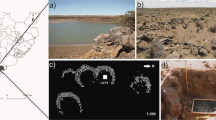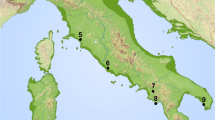Abstract
Tamar Hat rockshelter (Béjaïa, northeastern Algeria) has yielded a lithic assemblage showing general characteristics of an Iberomaurusian Early Late Stone Age nature. Specific “becs,” which we shall call “becs of Tamar Hat,” appear as an important component of the assemblage in the upper occupations, which occurred at the end of Late Glacial Maximum. These becs, from a technological point of view and especially by their shaping processes, constitute a reliable reference collection, though showing morphological variability resulting in part to the reduction process. The use-wear analysis conducted, based on a microscopic examination validated by experimentation, testifies the becs would have functioned for engraving hard bone, such as those of deer. Other scars observed on the sharp edge and lower face near the active portion of the tool are caused by hafting. Hence, the results of the technological and functional analyses of the becs from Tamar Hat reveal the presence of specialized activities in the upper occupations, related to the animal bone processing. These results are supported by the archaeozoological study, which confirms that the site functioned as a seasonal habitat, where Megacerin deer was exploited in the upper occupations for utilitarian, non-food purposes. The emergence of the use of the becs of Tamar Hat is synchronous with the end of the Upper Paleolithic, prior to the expansion of bec use in the Upper Magdalenian of Europe, where technical and stylistic convergences were observed. This raises the question of the emergence of these lithic implements in North Africa and the possible spread of similar industries elsewhere.
Résumé
Le gisement de Tamar Hat (Bejaia, Algérie nord-occidentale) a livré une industrie développant les caractères généraux d’un Ibéromaurusien du LSA ancien. Des becs particuliers que nous appellerons “becs de Tamar Hat” apparaissent comme une composante importante des occupations supérieures de ce site à la fin du Dernier Maximum Glaciaire Ces becs d’un point de vue technologique et dans les procédés de mise en forme du rostre, constituent un ensemble homogène susceptible toutefois d’une certaine variabilité morphologique, résultant en partie de processus de réductions. L’analyse fonctionnelle qui s’est basée sur l’examen microscopique des microtraces observées sur ces becs et validée par l’expérimentation a indiqué que ces derniers auraient fonctionné pour le rainurage de matières dures animales comme le bois de cerf. D’autres traces visibles sur le fil du trenchant et sur la face inférieure à proximité de la partie active seraient plutôt provoquées par l’emmanchement. Les résultats de l’analyse techno-fonctionnelle des becs de Tamar Hat concluent donc, à la présence d’activités spécialisées dans les occupations supérieures de ce site en rapport avec le travail de la matière dure animale. Ces résultats sont corroborés par ceux de l’analyse archéozoologique des restes fauniques qui attestent que le site a fonctionné comme un habitat préhistorique saisonnier et confirment la présence et l’exploitation du cerf mégacérin dans les niveaux supérieurs dans des buts utilitaires autres qu’alimentaires. Il est intéressant de noter que l’apparition et l’intensification de l’usage des becs de Tamar Hat se sont effectuées au cours d’une période synchrone de la fin du Paléolithique supérieur, antérieurement à leur expansion au sein du Magdalénien supérieur du Nord de l’Europe où des convergences techniques et stylistiques ont été observées. Ceci soulève la question de l’émergence de ces artéfacts lithiques en Afrique du Nord et leur probable expansion ailleurs.









Similar content being viewed by others
References
Adams, W.Y. & Adams, E.W. (1991). Archaeological typology and practical reality: A dialectical approach to artifact classification and sorting. Cambridge: Cambridge University Press.
Arambourg, C., Boule, M., Vallois, H., Verneau, R. (1934). Les grottes paléolithiques des Beni Ségoual (Algérie). Archives de l’Institut de Paléontologie Humaine, n° 13. Paris: Édition Masson.
Balout, L. (1955). Préhistoire de l’Afrique du Nord: Essai de chronologie. Paris: Arts et Métiers Graphiques.
Barich, B. E., Garcea, E. A. A., & Giraudi, C. (2006). Between the Mediterranean and the Sahara: The geoarchaeological reconnaissance in the Jebel Gharbi, Libya. Antiquity, 80, 567–582.
Barich, B.E. & Garcea, E.A.A. (2008) Ecological Patterns in the Upper Pleistocene and Holocene in the Jebel Gharbi, Northern Libya: Chronology, Climate and Human Occupation. African Archaeological Review, 25(1-2)87-97.
Barker, G., Bennett, P., Farr, L., et al. (2012). The Cyrenaican Prehistory Project 2012: The fifth season of investigations of the Haua Fteah cave. Libyan Studies, 43, 115–136.
Barton, R. N. E., Bouzouggar, A., Collcutt, S. N., Gale, R., Higham, T. F. G., Humphrey, L. T., Parfitt, S., Rhodes, E., Stringer, C. B., & Malek, F. (2005). The late Upper Palaeolithic occupation of the Last Glacial Maximum. African Archaeological Review, 22, 77–98.
Barton, R. N. E., Bouzouggar, A., Hogue, J. T., Lee, S., Collcutt, S. N., & Ditchfield, P. (2013). Origins of the Iberomaurusian in NW Africa: New AMS radiocarbon dating of the Middle and Later Stone Age deposits at Taforalt Cave, Morocco. Journal of Human Evolution, 65, 266–281.
Barton, R. N. E., Bouzouggar, A., Collcutt, S. N., Carri Marco, Y., Clark-Balzan, L., Debenham, N. C., & Morales, J. (2015). Reconsidering the MSA to LSA transition at Taforalt Cave (Morocco) in the light of new multi-proxy dating evidence. Quaternary International, 413, 36–49.
Beyries, S., Janny, F., & Audouze, F. (2005). Débitage, matière première et utilisations des becs sur le site de Verberies « le Buisson Campin » (Oise) dans le Nord de la France. Revue archéologique de Picardie, special issue, 22, 15–24.
Bouzouggar, A., Barton, R. N. E., Blockley, S., Bronk-Ramsey, C., Collcutt, S. N., Gale, R., Higham, T. F. G., Humphrey, L. T., Parfitt, S., Turner, E., & Ward, S. (2008). Reevaluating the age of the Iberomaurusian in Morocco. African Archaeological Review, 25, 3–19.
Brahimi, C. (1969). L’industrie lithique de l’abri de Tamar Hat (petite Kabylie). Libyca, 17, 93–99.
Camps-Fabrer, H. (1966). Matériaux et art mobilier dans la préhistoire nord-africaine et saharienne. Mémoire du C.R.A.P.E. n° 5, Alger.
Close, A. E. (1977). Identification of style in lithic artefacts from North East Africa (314 p). Cairo: Mémoires de l’Institut d’Égypte, 61, S.O.P. Press.
Close, A. E. (1978). The identification of style in lithic artefacts. World Archaeology, 10(2), 223–237.
Close, A. E. (1981). The Iberomaurusian sequence at Tamar Hat. Libyca, 28-29, 69–103.
de Sonneville-Bordes D., & Perrot J. (1955). Lexique typologique du Paléolithique supérieur, Outillage lithique, III - Outils composites - Perçoirs. Bulletin de la Société préhistorique de France, 52(1-2),76–79.
Douka, K., Jacobs, Z., Lane, C., Grün, R., Farr, L., Hunt, C., Inglis, R. H., Reynolds, T., Albert, P., Aubert, M., Cullen, V., Evan, H. E., Kinsley, L., Roberts, R. G., Tomlinson, E. L., Wulf, S., & Barker, G. (2014). The chronostratigraphy of the Haua Fteah cave (Cyrenaica, northeast Libya). Journal of Human Evolution, 66, 39–63.
Groucutt, H. S., Petraglia, M. D., Bailey, G., Scerri, E. M. L., Parton, A., Clark-Balzan, L., Jennings, R. P., Lewis, L., Blinkhorn, B., Drake, N. A., Breeze, P. S., Inglis, R. H., Deves, M. H., Meredith-Williams, M., Boivin, N., Thomas, M. G., & Scally, A. (2015). Rethinking the dispersal of Homo sapiens out of Africa. Evolutionary Anthropology, 24, 149–164.
Hachi, S. (1987). Les cultures de l’Homme de Mechta El Arbi. Le gisement d’Afalou Bou Rhummel (massif des Babors, Algérie): les niveaux supérieurs 13000–11000 BP. Thèse de Doctorat 3ème cycle. Université d’Aix-en-Provence.
Hachi, S. (1996). L’Ibéromaurusien, découverte des fouilles d’Afalou. L’Anthropologie, 100(1), 77–87.
Hogue, J. T., & Barton, R. N. E. (2016). New radiocarbon dates for the earliest Later Stone Age microlithic technology in Northwest Africa. Quaternary International, 413, 62–75.
Keeley, L.H. (1981). Premiers résultats de l’analyse des micro-traces d’utilisation de quelques objets. In F. Adouze, D. Cahen, L.H. Keeley et al. (Eds.), Le site magdalénien du Buisson Campin à Verberie (Oise) (pp. 99–141). Paris: CNRS (Gallia Préhistoire, 24).
Keeley, L. H. (1988). Lithic economy, style and use: A comparison of three late Magdalenian sites. Lithic Technology, 17(1), 19–25.
Kim, K-J. (2010). Etude fonctionnelle de perçoirs du niveau inférieur de Verberie. Mémoire de Master 2 de l’Université de Paris X.
Leroi-Gourhan, A. (1997). Dictionnaire de la Préhistoire. PUF : Paris: 1988 (coll.« Quadrige », 1997).
Linstadter, J., Eiwanger, J., Mikdad, A., & Weniger, G. C. (2012). Human occupation of Northwest Africa: A review of Middle Palaeolithic to Epipalaeolithic sites in Morocco. Quaternary International, 274, 158–174.
Lucarini, G. & Mutri, G. (2014). Microlithism and landscape exploitation along the Cyrenaican Coast between the Late Pleistocene and the Holocene: A matter of continuity. In K. Boyle, R.J. Rabett, & C.O. Hunt (Eds.), Living in the landscape. Essays in Honour of Graeme Barker (pp. 109-120), Cambridge: McDonald Institute Monographs, University of Cambridge.
Merzoug, S. (2005). Comportements de subsistance des Ibéromaurusiens d’après l’analyse archéozoologique des mammifères des sites de Tamar Hat, Taza1 et Columnata (Algérie). Thèse de Doctorat, Muséum national d’Histoire naturelle de Paris.
Merzoug, S. (2012). Essai d’interprétation du statut économique du Megaceroides algericus durant l’Ibéromaurusien dans le massif des Babors (Algérie). Quaternaire, 23(2), 141–148.
Merzoug, S., & Sari, L. (2008). Re-examination of the zone I material from Tamar Hat (Algeria): Zooarchaeological and technofunctional analyses. African Archaeological Review, 25(1–2), 57–73.
Roux, V. (2008). Evolutionary trajectories of technological traits and cultural transmission. In M. Stark, B. Bowser, & L. Horne (eds.), Cultural transmission and material culture. Breaking down boundaries (pp. 82–104), Tucson: University of Arizona Press.
Sari, L. (2012). L’Ibéromaurusien, culture du Paléolithique supérieur tardif. Approche technologique des productions lithiques taillées de Tamar Hat, Rassel et Columnata (Algérie). Thèse de Doctorat, Paris X-Nanterre University.
Sari, L. (2014). Technological change in Iberomaurusian culture: The case of Tamar Hat, Rassel and Columnata lithic assemblages (Algeria). Quaternary International, 320, 131–142.
Saxon, E.C. (1975). Prehistoric economies of the Israeli and Algerian littorals: 18 000–8000 BP. Ph. D. dissertation, Cambridge University, Jesus College.
Saxon, E. C., Close, A., Cluzel, C., Morse, V., & Shackelton, N. J. (1974). Results of recent investigations at Tamar Hat. Libyca, 22, 49–91.
Schmider, B. (1982). The magdalenian culture of the Paris river-basin and its relationship with the Nordic cultures of the Late Old Stone Age. World Archaeology, 14(2), 259–269.
Schmider, B. (1988). Un outil spécialisé dans le Magdalénien du Bassin Parisien : le bec, sa place dans l’habitat. In Cultures et industries lithiques en milieu loessique (195–200), Revue archéologique de Picardie, n°1–2. Actes du colloque international, Amiens 9–11 décembre 1986.
Shennan, S. (2000). Population, culture history, and the dynamics of culture change. Current Anthropology, 41(5), 811–835.
Symens, N. (1986). A functional analysis of selected stone artifacts from the magdalenian site at Verberie, France. Journal of Field Archaeology, 13, 213–222.
Tixier, J. (1963). Typologie de l’Épipaléolithique du Maghreb. Mémoire du C.R.A.P.E, n° 2, Paris, éd. Arts et Métiers Graphiques, 212 p.
Valentin, B. (1995). Les groupes humains et leurs traditions au Tardiglaciaire dans le Bassin parisien. Apports de la technologie lithique comparée, Sciences de l’Homme et Société. Thèse de Doctorat. Université Panthéon-Sorbonne - Paris I, 1995. Français. [http://hal-paris1.archives-ouvertes.fr/tel-00267435/fr/].
Will, M., Mackay, A., & Phillips, N. (2015). Implications of Nubian-like core reduction systems in Southern Africa for the identification of early modern human dispersals. PLoS One, 10(6), e0131824. https://doi.org/10.1371/journal.pone.0131824.
Acknowledgements
We would like to express our thanks to the organizers of the session at the Society of Africanist Archaeologists (SAfA) biennial meeting in Toulouse, 2016—Emilie Campmas, Eleanor Scerri, Emanuelle Stoetzel, and Aicha Oujaa—for the opportunity to present this research. We are also gratefully indebted to the reviewers for their valuable observations and criticism. We would like to express also our sincerest thanks to all members of the Laboratory of Prehistory and Technology (UMR 7055) in France, who have most generously provided us the metallurgical microscope for observing use-wear on the surface of lithic tools.
Author information
Authors and Affiliations
Corresponding author
Ethics declarations
We have complied with ethical standards throughout.
Rights and permissions
About this article
Cite this article
Sari, L., Kim, KJ. Lithic Economy and Specialized Activities Among the Iberomaurusian Populations of Tamar Hat Rockshelter (Northeastern Algeria). Afr Archaeol Rev 34, 543–556 (2017). https://doi.org/10.1007/s10437-017-9274-y
Published:
Issue Date:
DOI: https://doi.org/10.1007/s10437-017-9274-y




